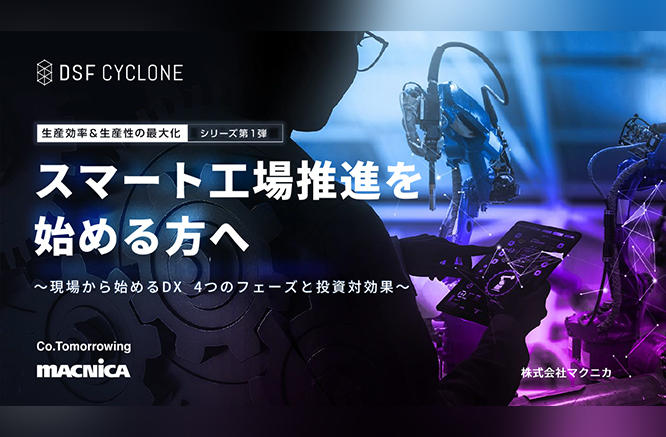
Four phases of smart factory realization and return on investment
A smart factory is difficult to obtain a clear return on investment.
DSF Cyclone connects production results and production plans with structured data to realize a "highly productive factory" and grasp the effects.
We will introduce the flow of introducing it step by step from the manufacturing site and expanding it to the entire factory while rotating the kaizen cycle, divided into four parts.
Phase 1
aim settingPhase 2
Selection of pilot linePhase 3
Roadmap formulationPhase 4
Consensus building among stakeholdersPhase 1 goal setting
Interlocking target indicators divided into organizational hierarchies
The purpose of promoting smart factories is to "continue to be a profitable factory."
For its success, it is necessary to set target indicators according to the organizational hierarchy.
For a series of manufacturing processes produced by different equipment, we set target indicators for each with an awareness of the organizational hierarchy, and create a state in which profits are increasing with common indicators.

For example, it is important to be able to understand how productivity in a series of processes has improved because line production efficiency has improved by XX% through kaizen activities at the production site.

Selection of Phase 2 Pilot Line
① Selection of products
Choose a product with a stable production volume.
(2) Definition of scope of efforts
It is important to consider realities such as:
- Is it possible to acquire data from the production site?
- Is it possible to install a network for data collection and secure a power source?
- Are the stakeholders in the manufacturing process you are working on cooperative?
(3) Decide on a pilot line based on how easy it is to work on
First of all, it is important to select a pilot line that can provide a successful experience at an early stage.
Formulation of Phase 3 Roadmap
One characteristic of digital transformation is that the more data it accumulates, the more effective it can be. It is important for continuous investment to formulate a realistic and step-by-step roadmap without forcibly committing a large economic effect from the initial stage.
Data accumulation and data utilization with a view to "horizontal deployment to the entire manufacturing process"

Phase 4 consensus building
The people involved in the smart factory promotion project exist in multiple departments. It is important to share goals and specific roadmaps with all parties involved, and then build a consensus on when and what kind of support is needed.
| name | definition |
|---|---|
| Project manager | Approve and be responsible for smart factory promotion projects. In many cases, the Member of the Board in charge of the production department and the factory manager are in charge. |
| Smart factory promoter | Set objectives, formulate a roadmap, coordinate system introduction, etc. for the promotion of smart factories, and carry out specific system utilization and horizontal deployment work. |
| Production site leader | After introducing the system, the system will be used at the production site. In order to improve production efficiency, it is necessary to give specific instructions to workers at the production site. |
| production floor workers | Carrying out manufacturing activities at production sites. Responsible for inputting business data and Kaizen activities in promoting smart factories. |
| Information system department | Comply with internal security policies in system settings and system installation. |
| production manager | Formulate a production plan and instruct the factory on which product to make, how much, and by when. After introducing the smart factory system, it is up to the production manager to obtain a sufficient return on investment. |
Click here for service inquiries
Want to know more?
white paper

Maximizing Production Efficiency & Productivity Series 1
For those who start promoting smart factories
4 phases of DX starting from the field and return on investment
*Application is required to download.

